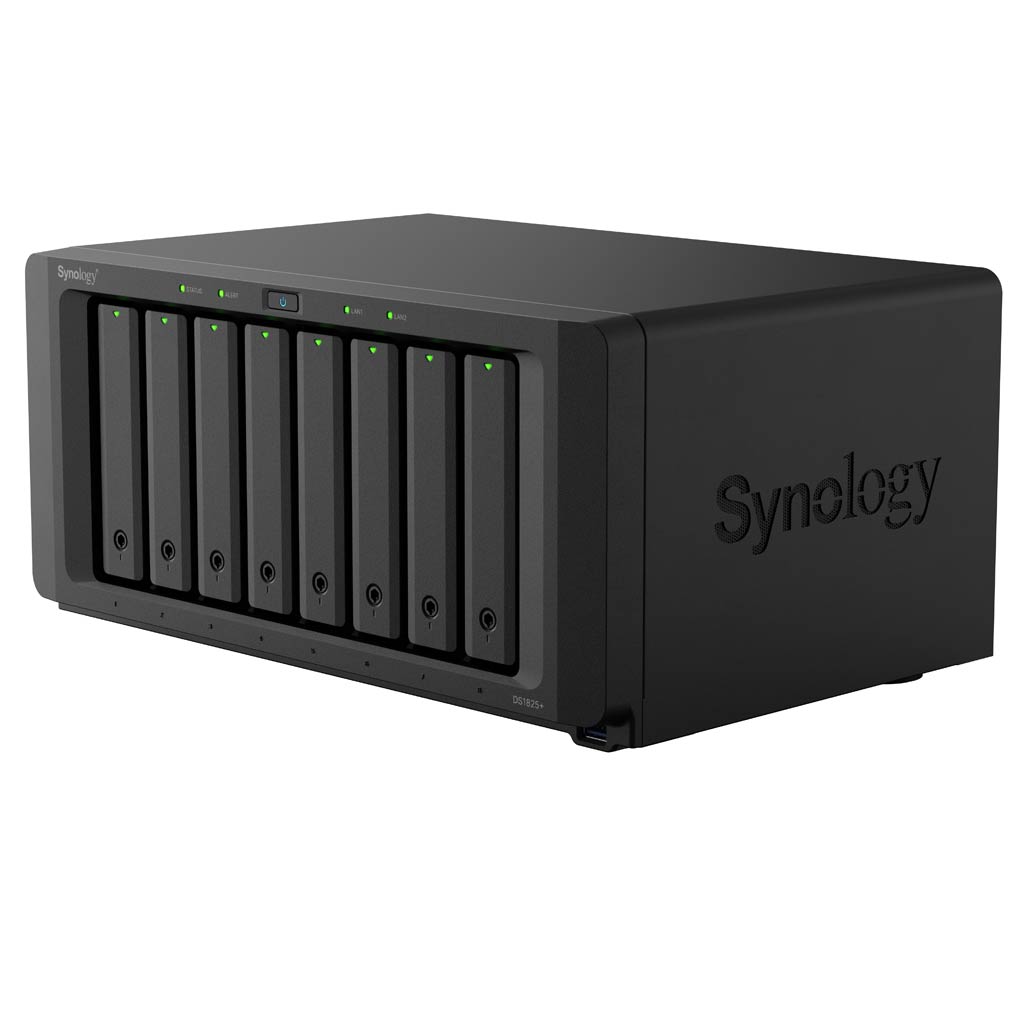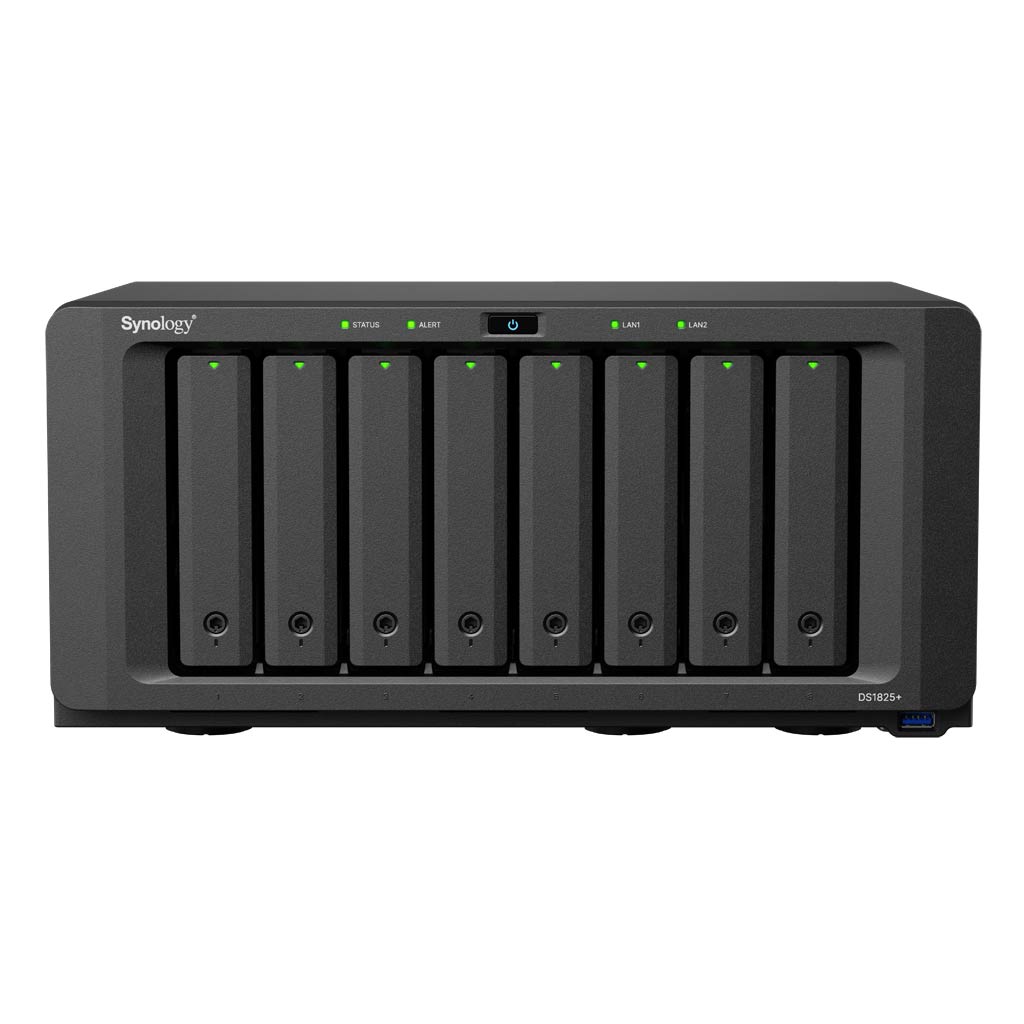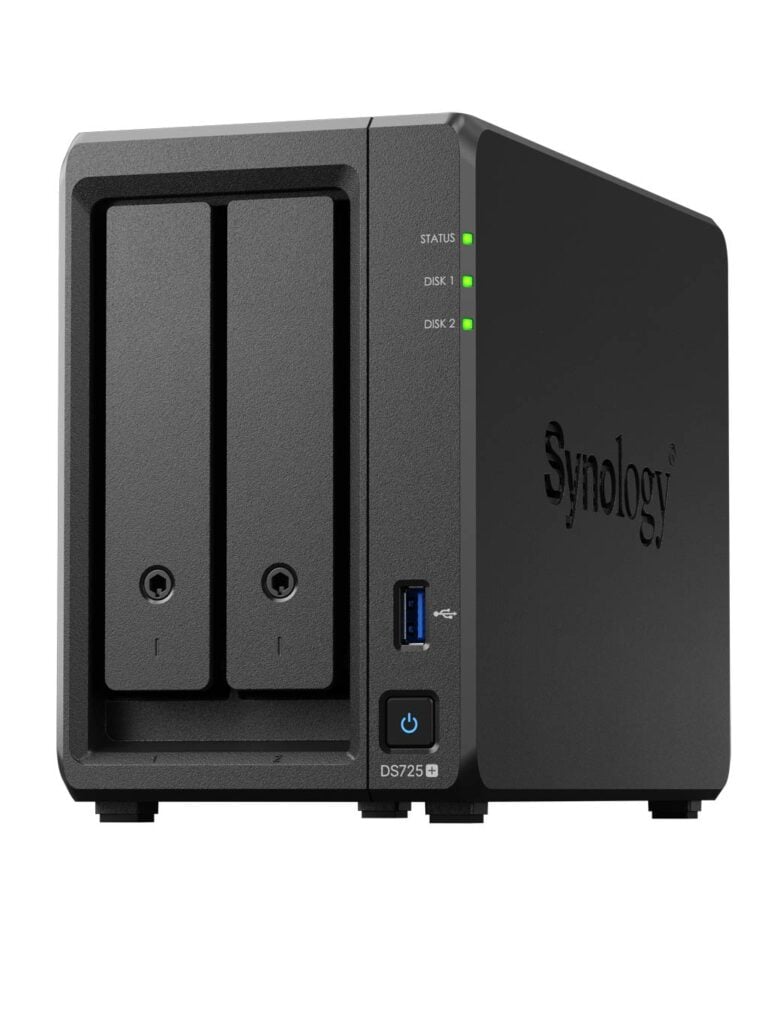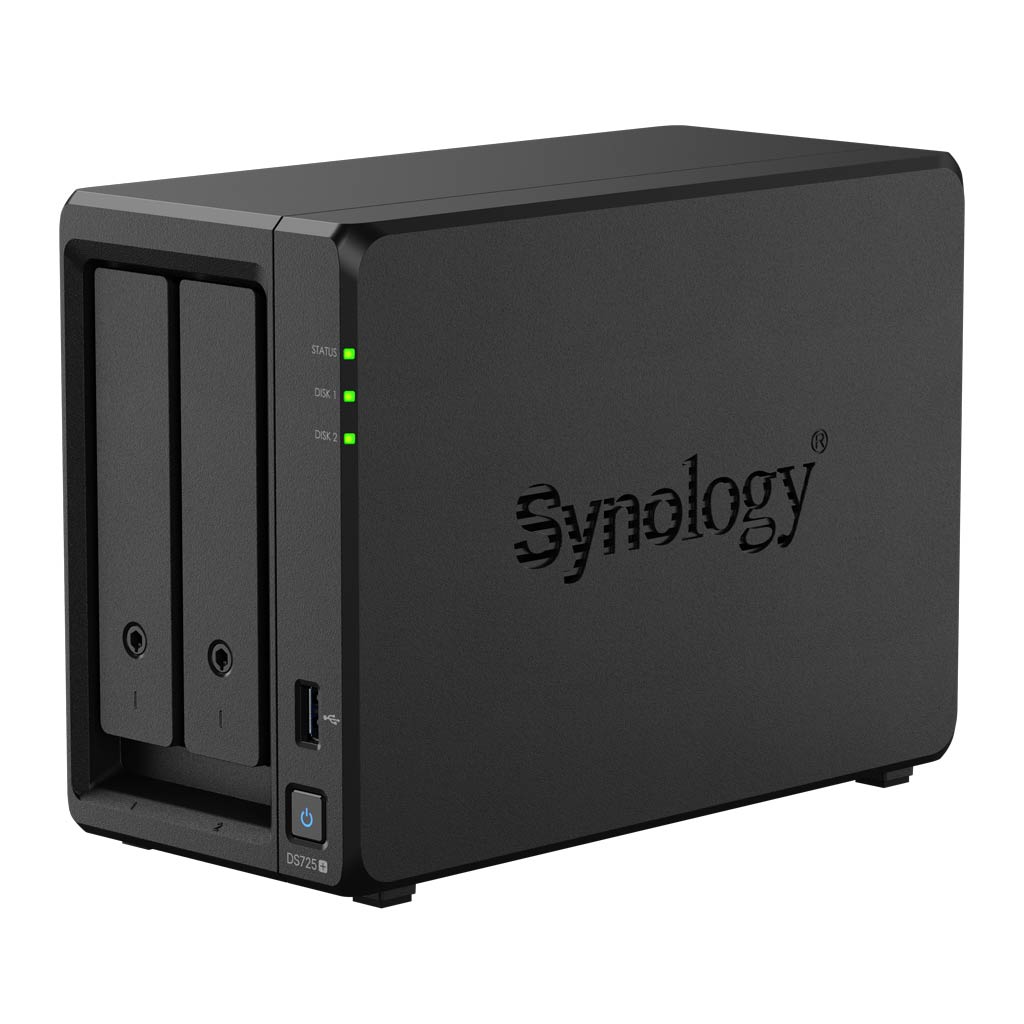Synology today officially releases its two additional DiskStation NAS servers in its Plus family, the DS1825+ and DS725+.
Judging from their hardware specs, while the former can pass for a minor four-year upgrade to the previous DS1821+, the latter, like the recently available DS925+, is an outright downgrade compared to the previous model, the DS723+ that came out two years ago.
Let’s start with the DS1825+.

Synology DS1825+ vs. DS1821+: A simple 2.5GbE upgrade
As the name suggests, the DS1825+ is a NAS server with eight native drive bays, allowing it to host up to eight SATA hard drives or SSDs. After that, it can handle up to two expansion units, the newly announced DX525, to add up to ten more drives, delivering up to 360TB of raw storage from the drive bays, before counting the two M.2 slots that host two NVMe drives for caching or an all-flash storage pool.
If you’re wondering where the 360TB number comes from, that’s when you use all 18 drive bays with 20TB drives. And 20TB is currently the largest capacity among hard drives that Synology offers, which brings us to the elephant in the room: Yes, like the rest of the servers in the 2025 Plus (+) family, the DS1825+ and the DS925+ both follow Synology’s new storage requirements. You must use drives on the compatible list, which currently includes only Synology-branded drives.
Synlogy HCL policy update
At the beginning of 2025, Synology implemented a strict hardware compatibility requirement, known as the 2025 storage lock-in HCL policy, causing its 2025 NAS servers to work only with Synology’s approved storage devices, namely its expensive self-branded drives.
On October 7, 2025, in response to public outcry, Synology released DSM 7.3, which walks back the storage lock-in policy and allows its servers to use third-party SATA drives again, as was the case prior to 2025.
Other than that, the new DS1815+ is somewhat underwhelming when compared to the previous DS1821+ in terms of hardware specifications. Other than the two 2.5GbE ports, it’s essentially the same. In fact, when upgraded to 10GbE and max RAM, the two are virtually the same, shareware-wise.
The table below compares the new server’s hardware specifications to those of the previous model.
Synology DS1825+ vs. DS1821+: Hardware specifications
 |  | |
|---|---|---|
| Model | DS1825+ | DS1821+ |
| CPU | AMD RyzenV1500B quad-core 2.2 GHz | |
| System Memory (stock) | 8GB DDR4 | 4GB DDR4 |
| Max Memory | 32 GB (16 GB x 2 slots) | |
| Dimensions | 6.53 x 13.5 x 9.57 in (166 x 343 x 243 mm) | |
| Weight | 13.23 lbs (6.0 kg) | |
| Drive Bays (native) | 8 | |
| Expansion Support | Yes (two units) | Yes (two units) |
| Expansion Unit | DX525 (USB-C) | DX517 (eSATA) |
| Drive Interface | 2.5 or 3.5 SATA Drives, Hot-swappable | |
| Maximum Capacity (at launch) | 160TB (8x 20TB drives) | 128TB (8x 16TB drives) |
| Built-in M.2 Slots | Two (caching or storage pool) | Two (caching only) |
| RAID Types | SHR, Basic, JBOD, RAID 0, RAID 1, RAID 5, RAID 6, RAID 10 | |
| Ports / Interfaces | 2x RJ-45 2.5GbE LAN 3x USB 3.0, 2x USB-C (expansion) | 4x RJ-45 1GbE LAN, 3x USB 3.0, 2x eSATA (expansion) |
| Link Aggregation Support | Yes (5Gbps bonded link) | Yes (2Gbps bonded link) |
| PCIe Expansion | 1x Gen 3 x8 PCIe slot | |
| Add-in-card Support (not included) | Synology 10GbE PCIe add-on cards | |
| Operating System | DSM 7 (and later) | DSM 6 (and later) |
| File System (Internal / External) | Btrfs, EXT4 / Btrfs, EXT4, EXT3, FAT, NTFS, HFS+, exFAT (app required) | |
| US Launch Price (check street prices!) | $1149.99 (diskless) | $949.99 (diskless) |
| Warranty | 3 years | |
As shown in the table above, the DS1825+ doesn’t come with a Network Upgrade port, like the DS1525+. Instead, it uses the relatively new PCIe Gen 3 expansion slot, similar to its predecessor. That said, the extra amount of RAM (stock) and the two 2.5GbE ports are the only things that set it apart from the four-year-old DS1821+, which also accounts for its higher retail cost.
As for the new expansion units, the new server’s use of USB-C, while making a lot of sense, will result in slower performance than eSATA, as it still features the USB 3.2 Gen 1 (USB 3.0) standard. Considering the number of native bays and the large capacities of hard drives, it is unlikely that either of these servers will ever need to resort to an expansion unit.


Synology DS725+ vs. DS723+: A downgrade in upgradability
The new DS725+, like the DS925+, is somewhat of a downgrade compared to the previous model, the DS723+, due to the lack of a 10GbE upgrade option.

Out of the box, the new DS725+ comes with a 2.5GbE port and a Gigabit port and is clearly superior to the DS723+ in terms of performance. However, the old model comes with a Network Upgrade slot to host a Synology E10G22-T1-Mini module, which enables it to function as a 10GbE server.
Here’s the important part: The old model supports third-party hard drives. Considering the significantly higher cost of Synology-branded drives, the savings from storage are likely enough to offset the cost of an E10G22-T1-Mini module.
Other than that, the new server also comes with more RAM out of the box to justify its higher retail cost (diskless) since it’s practically the same as the previous model. The table below shows the hardware specs of the two.
Synology DS725+ vs. DS723+: Hardware specifications
 |  | |
|---|---|---|
| Model | Synology DS725+ | Synology DS723+ |
| CPU | AMD Ryzen R1600 Dual-core 2-core 2.6GHz / 3.1 GHz (turbo) | |
| System Memory | 1x 4 GB DDR4 | 1x 2GB DDR4 |
| Max Memory | 32GB via two memory slots (16GB x 2) | |
| Dimensions | 6.53 x 4.17 x 8.78 in (166 x 106 x 223 mm) | |
| Weight | 3.33 lbs (1.51 kg) | |
| Drive Bays (native) | 2 | |
| Expansion Support | 1x DX525 (USB-C) | 1x DX517 (eSATA) |
| Drive Interface | SATA 6Gbps/3Gbps (hot-swappable) | |
| Built-in M.2 Slots (NVMe) | Two (cache or storage) | |
| Drive Support | 3.5″ SATA HDD 2.5″ SATA SSD/HDD M.2 2280 NVMe SSD | |
| RAID Types | Hybrid RAID (SHR), Basic, JBOD, RAID 0, and RAID 1 | |
| Ports | 1x RJ-45 2.5GbE LAN 1x RJ-45 1GbE LAN 1x USB 3.0, 1x USB-C (expansion) | 2x RJ-45 1GbE LAN, 1x USB 3.0, 1x eSATA (expansion) |
| PCIe Expansion | None | |
| Add-on Card (not included) | None | 10GbE E10G22-T1-Mini module |
| DiskStation Manager (operating system) | DSM 7 (and later) | |
| File System | Btrfs, EXT4, EXT3, FAT, NTFS, HFS+, exFAT | |
| US Launch Price (check street prices!) | $519.99 | $449.99 |
| Warranty | 3 years | |


Availability and the final thoughts
Both the DS1825+ and DS725+ are available for purchase today. As to whether you should get them, that depends on whether you’re willing to buy into the new storage lock-in practice of Synlogy. That’s because, other than the new storage requirement, both servers are remarkably similar to their respective previous models, and in certain situations, they may even be worth it in terms of hardware specs.
One thing is sure: if you decide to stay with the older models, you’ll get the same experience and enjoy the freedom of using third-party drives of your choice without missing much. Synology NAS servers generally offer similar real-world experience thanks to the fact that they share the same robust DSM 7 operating system, and differ primarily in their hardware capabilities, which the new servers have little to offer, if anything.



I guess the tipping point will come when ugreen’s software becomes more robust and mature. Synology is stagnating, backing themselves into a corner, and opening the door wide to competition. Thats a bad trifecta.
UGREEN still has a very long way to go. Its OS and apps are still in early stages. But for most home users, it is close to enough. It needs a native Plex app first For example.